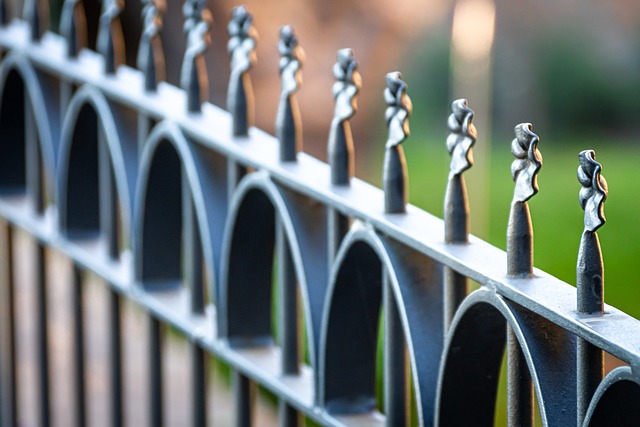Fences serve as both structural elements and design accents in outdoor spaces, with wood being a popular choice for its aesthetic appeal and versatility. To maintain their beauty and longevity, proper fence staining and sealing are essential. This comprehensive guide delves into the world of fence maintenance, exploring the benefits and types of staining, selecting the ideal product for your wood, and implementing a robust sealing process. Discover expert tips for regular care, ensuring your wooden fences remain vibrant and protected against environmental factors.
- Understanding Fence Staining: Benefits and Types
- Choosing the Right Stain for Your Wood
- The Sealing Process: Protection Against Elements
- Step-by-Step Guide to Professional Fence Maintenance
- Tips for Longevity: Regular Care and Maintenance Routines
Understanding Fence Staining: Benefits and Types
Fence staining is an essential process for maintaining and enhancing the beauty of wooden fences. By applying a protective coat of stain, you can safeguard your fence from the elements, prolong its lifespan, and add aesthetic appeal. Understanding the benefits and different types of stains is crucial to making an informed decision.
Benefits include increased durability, as stains act as a barrier against water, UV rays, and extreme temperatures, which can cause fading or cracking. Staining also enhances the natural wood grain, providing a rich, vibrant finish that can transform the overall look of your fence. Various types of stains are available, each with unique characteristics: semi-transparent stains allow some color penetration while still showcasing the wood’s natural tone, transparent stains offer better color vibrancy, and solid or semi-solid stains provide complete coverage, transforming the fence into a feature piece.
Choosing the Right Stain for Your Wood
When considering fence staining and sealing, selecting the appropriate stain is a pivotal first step. The right stain not only enhances the aesthetic appeal of your wooden fence but also plays a crucial role in protecting it from the elements. Different stains offer varying levels of protection and color options, making it essential to choose one tailored to your needs.
Factors like wood type, desired color, and climate conditions should guide your selection. For instance, if you have redwood or cedar, opt for a water-based stain that preserves the wood’s natural tone while offering UV protection. In regions with frequent rainfall or high humidity, a semi-transparent or transparent stain provides better resistance to moisture, preventing rot and maintaining the fence’s integrity over time.
The Sealing Process: Protection Against Elements
The sealing process is a crucial step in maintaining the health and aesthetics of your wooden fence. It involves applying a protective layer to the wood, which acts as a barrier against various elements that can cause damage over time. This includes water, UV rays from the sun, and harsh weather conditions, all of which can lead to fading, cracking, and rot.
Sealing is accomplished by using specialized coatings or paints designed specifically for outdoor use. These products penetrate the wood’s surface, creating a shield that repels moisture and blocks ultraviolet light. By regularly sealing your wooden fence, you’re not only enhancing its visual appeal but also extending its lifespan. A well-maintained, sealed fence can endure harsh environmental conditions, ensuring it remains strong and attractive for years to come.
Step-by-Step Guide to Professional Fence Maintenance
Step-by-Step Guide to Professional Fence Maintenance
The process begins with thorough cleaning, using a pressure washer or a combination of soap and water to remove dirt, mold, and mildew buildup. Once the fence is clean, assess any damaged areas that require repair before staining. Fix or replace rotted or broken boards to ensure a smooth finish. Next, apply a coat of primer specifically designed for wood, allowing it to dry completely. This step prepares the surface for the stain, extending its lifespan.
After priming, choose a high-quality fence stain suitable for your wooden fence’s material and desired color. Apply the stain evenly using a brush or roller, following the manufacturer’s instructions for drying times between coats. Seal the fence by coating it with a protective sealer to safeguard against the elements. Regularly maintain your fence in this manner to protect its beauty and longevity.
Tips for Longevity: Regular Care and Maintenance Routines
Regular care and maintenance routines are essential to ensure your wooden fence remains in top condition, extending its lifespan significantly. A consistent cleaning schedule will help remove dirt, mold, and mildew buildup, which can degrade the paint or stain over time. Use a soft brush or garden hose to gently clean the fence surface annually, especially in areas with heavy foot traffic or exposure to harsh weather conditions.
Additionally, applying a fresh coat of sealant every 2-3 years is vital. This protective layer shields the wood from damaging UV rays, moisture, and extreme temperatures, preventing cracks and peeling. Choose a high-quality sealant designed for outdoor use and follow the manufacturer’s instructions for optimal results. Regular sealing not only enhances the fence’s aesthetic appeal but also acts as a barrier against elements that could accelerate the aging process.
